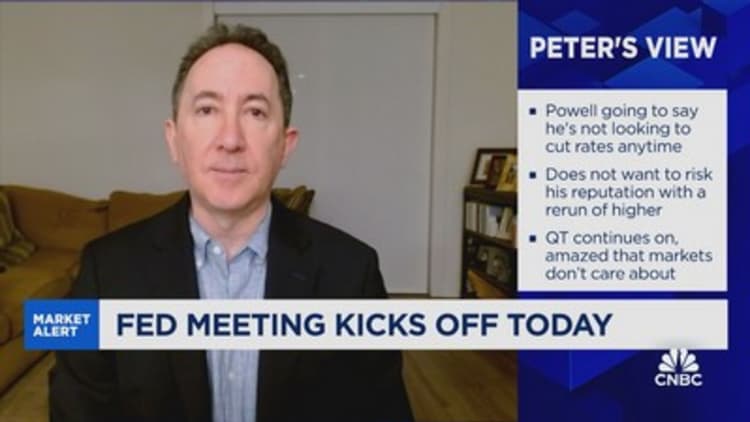Kentaroo Tryman | Maskot | Getty Images
Inflation declined slightly last month on the back of weaker prices at the gasoline pump and a broader easing of price pressures throughout the U.S. economy, experts said.
The consumer price index in November increased 3.1% from 12 months earlier, down from 3.2% in October, the U.S. Bureau of Labor Statistics said Tuesday.
“There is still a lot of disinflationary pressure in the system,” which will likely drive inflation even lower heading into 2024, said Sarah House, senior economist at Wells Fargo Economics.
The CPI is a key barometer of inflation, measuring how quickly the prices of things from fruits and vegetables to haircuts and concert tickets are changing across the U.S. economy.
The November reading is a significant improvement on the pandemic-era peak of 9.1% in June 2022 — the highest rate since November 1981. Prices are therefore rising much more slowly than they had been, and in some cases even falling outright.
“Inflation is still on the high side of what I think everyone would feel comfortable with, but it’s coming back down to earth steadily but surely,” said Mark Zandi, chief economist at Moody’s Analytics.
The U.S. Federal Reserve aims for a 2% annual inflation rate over the long term.
“I expect by this time next year we’ll be back within spitting distance of the target,” Zandi said.
Gasoline prices declined again
As in October, gasoline prices were a big contributor to falling inflation in November, economists said.
Gasoline prices dropped 6% in November, according to Tuesday’s CPI report. They had dropped 5% in October.
Average nationwide prices for regular-grade gasoline declined by about 24 cents a gallon between Oct. 30 and Dec. 4, to $3.23 a gallon from $3.47, according to weekly data published by the U.S. Energy Information Administration.
More from Personal Finance:
The Federal Reserve could achieve a soft landing after all
More retirement savers are borrowing from their 401(k) plan
People are spending hundreds a month on dating apps
By comparison, in August and September, gasoline was a major contributor to increases in overall inflation readings. In August, for example, prices at the pump spiked 10.6% largely due to dynamics in the market for crude oil, which is refined into gasoline.
Those supply-and-demand dynamics can “change in a minute,” and therefore declining gas prices may not persist, said Mark Hamrick, senior economic analyst at Bankrate. “But you take it where you can get it.”
What’s happening under the surface
Energy prices can whipsaw inflation readings due to their volatility. Likewise with food.
That’s why economists like to look at a measure that strips out these prices when assessing underlying inflation trends.
This pared-down measure — known as the “core” CPI — was flat in November relative to October, holding steady at an annual rate of 4%.

Shelter inflation has been stubbornly high but should soon start to throttle back significantly given a softening in national rent prices, Zandi said. That trend should continue into the new year given rising vacancy rates and ample supply hitting the market, he added.
Other categories with “notable” increases in the past year include motor vehicle insurance, the price of which increased 19.2%; recreation, including admission to movies, concerts and sporting events, 2.5%; personal care, 5.2%; and new vehicles, 1.3%, according to the bureau.
Why inflation is returning to normal
At a high level, inflationary pressures — which have been felt globally — are due to an imbalance between supply and demand.
For example, energy prices spiked in early 2022 after Russia invaded Ukraine amid fears of a supply disruption in energy commodities, such as oil.
Supply chains were snarled when the U.S. economy restarted during the Covid-19 pandemic, driving up prices for goods. Meanwhile, demand was strong as consumers, flush with cash from government stimulus and staying home for a year, spent liberally. Wages grew at their fastest pace in decades, pushing up businesses’ labor costs.
Now, those pressures have largely eased, economists said. Supply chains have normalized, and the labor market has cooled.
The Federal Reserve has raised interest rates to their highest level since the early 2000s to slow the economy. This policy tool makes it more expensive for consumers and businesses to borrow, and can therefore tame inflation as demand wanes amid those higher financing costs.
Easing inflation is welcome news for households. The average household lost buying power for over two years as high inflation outpaced wage growth, but that trend has reversed in the last several months.
Average hourly wages have increased 0.8% in the past year after accounting for inflation, the bureau said Tuesday.
“Having real wages turn positive does help provide some ammunition for consumers, many of whom are still [financially] stressed,” Hamrick said.
 EU News Digest Latest News & Updates
EU News Digest Latest News & Updates



